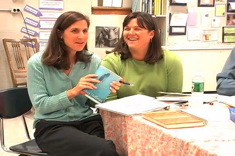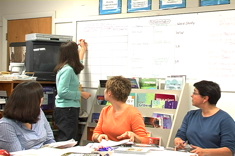To be able to ask a question clearly is two-thirds of the way to getting it answered.
John Ruskin
Our study groups just finished reading and discussing When Writing Workshop Isn’t Working: Answers to Ten Tough Questions, Grades 2-5 by Mark Overmeyer. Group members from three area schools met monthly for coffee and conversation. The groups came from different staffs, and consisted of a healthy mix of new and more “seasoned” teachers. As much as this was an advantage, it also meant at times there was a sense of reserve surrounding the comments made or the questions asked.
In any conversation, there is the careful negotiation of what to say and what to leave unsaid. This is a particular challenge when group members are still finding their comfort level with their teaching and relationships with staff members. I haven’t been teaching long enough . . . I don’t know enough about . . . I don’t want to disagree with _____ . . . all seemed to be unspoken thoughts that often hindered the free flow of conversation. I found that the challenge as a leader was to initiate discussions in such a way that would allow group members to respond more freely to both the reading and each other.
Sometimes the discussion around the reading felt forced. There were some meetings when I felt we were in a rut of simply reporting on the book’s content.
I liked the part where he said . . .
I thought this was a good idea . . .
During these conversation turns it was difficult to feel there even WAS a conversation. Group members simply listed facts from the book. I knew I needed some frameworks for discussion that would help us articulate our practice and beliefs.
Here are a few of the more successful attempts:
1. At the first meeting, work in groups of three, and have each person read one of the following sections: foreword, acknowledgments, and back cover. Answer the question, What did you find out about the author that is important to you? and share your thoughts with your group members.
2. After the first meeting, ask, “How does this chapter support and/or challenge your thinking about your writing instruction?” This two-column chart can be used for quick-writes in the group before the conversations, to spark deeper reflection and more thoughtful conversations. You can download the template by clicking here.
3. Use sticky notes or highlighters to record your thinking about this chapter. As you read, mark places in the text with a ? (a question you have) or a ! (something you find interesting) or a + (something you connect with). Share a ?, a !, and a + with the group.
4. After reading a few chapters, brainstorm questions and challenges group members have about writing workshop (use this template). Post on chart paper and work in partners to seek possible solution.
5. Bring an “artifact” from your classroom that illustrates an element of your writing workshop. How does it relate to the ideas we’ve been discussing from the book?
6. Finally, a conversation starter I wish I had tried—but will have in my study group folder for the next time! After reading the past few chapters, sketch an image of your ideal writing workshop.
a. What does the physical environment look like? What are you doing? What are your students doing?
b. What do you have in place now that will help you move toward this ideal? Do you have anything in place that is hindering you?
c. What new structure, routine, or idea do you need to implement to move toward this ideal?








